Historically black colleges and universities
Historically black colleges and universities (HBCUs) are institutions of higher education in the United States that were established before the Civil Rights Act of 1964 with the intention of primarily serving the African-American community. Most of these institutions were founded in the years after the American Civil War and are concentrated in the Southern United States. During the period of segregation in the United States prior to the Civil Rights Act, the overwhelming majority of higher education institutions were predominantly white and completely disqualified or limited African-American enrollment.[1][2] For a century after the end of slavery in the United States in 1865, most colleges and universities in the Southern United States prohibited all African Americans from attending, while institutions in other parts of the country regularly employed quotas to limit admissions of blacks.[3]
| Part of a series on | ||||||||||||
| African Americans | ||||||||||||
|---|---|---|---|---|---|---|---|---|---|---|---|---|
|
||||||||||||
|
||||||||||||
|
Religion
|
||||||||||||
|
Politics
|
||||||||||||
|
Civic / economic groups
|
||||||||||||
|
Sports
|
||||||||||||
|
Sub-communities
|
||||||||||||
|
Dialects and languages
|
||||||||||||
|
Population
|
||||||||||||
| ||||||||||||
There are 101 HBCUs in the United States, including both public and private institutions (of 121 institutions that existed during the 1930s).[4] Of these remaining HBCU institutions in the United States, 27 offer doctoral programs, 52 offer master's programs, 83 offer bachelor's degree programs, and 38 offer associate degrees.[5]
History
Private institutions
Most HBCUs were established in the South after the American Civil War, often with the assistance of religious missionary organizations based in the northern United States. HBCUs established prior to the American Civil War include Cheyney University of Pennsylvania in 1837 and Lincoln University in 1854. Wilberforce University was also established prior to the American Civil War; it was founded in 1856 via a collaboration between the African Methodist Episcopal Church of Ohio and the Methodist Episcopal Church (the latter a predominantly white denomination). Wilberforce was the third college to be established in the state of Ohio.
Exactly three months after the end of the Civil War, Atlanta University – now Clark Atlanta University – was founded on September 19, 1865, as the first HBCU in the Southern United States. Atlanta University was the nation's first graduate institution to award degrees to African Americans in the nation and the first to award bachelors degrees to African Americans in the South; Clark College (1869) was the nation's first four-year liberal arts college to serve African-American students. The two consolidated in 1988 to form Clark Atlanta University.[6] Shaw University, founded December 1, 1865, was the second HBCU to be established in the South. The year 1865 also saw the foundation of Storer College (1865–1955) in Harper's Ferry, West Virginia. Storer's former campus and buildings have since been incorporated into Harper's Ferry National Park.
Public institutions
In 1862,[7] the federal government's Morrill Act provided for land grant colleges in each state. Some educational institutions established under the Morrill Act in the North and West were open to blacks. But 17 states, mostly in the South, required their systems to be segregated and generally excluded black students from their land grant colleges. In response, Congress passed the second Morrill Act of 1890, also known as the Agricultural College Act of 1890, requiring states to establish a separate land grant college for blacks if blacks were being excluded from the existing land grant college. Many of the HBCUs were founded by states to satisfy the Second Morrill Act. These land grant schools continue to receive annual federal funding for their research, extension, and outreach activities.
Sports
In the 1920s and 1930s, historically Black colleges developed a strong interest in athletics. Sports were expanding rapidly at state universities, but very few black stars were recruited there. Race newspapers hailed athletic success as a demonstration of racial progress. Black schools hired coaches, recruited and featured stellar athletes, and set up their own leagues.[8][9]
Jewish refugees
In the 1930s, many Jewish intellectuals fleeing Europe after the rise of Hitler and anti-Jewish legislation in prewar Nazi Germany following Hitler's elevation to power emigrated to the United States and found work teaching in historically black colleges.[10][11] Many academics who left Germany and Poland and sought asylum in Britain found limited opportunities and turned their attention to the United States.[12] There, they hoped to continue their academic careers, but barring a scant few, they found little acceptance in elite institutions in Depression-era America, which also had their own undercurrent of antisemitism.[11] Many found work at historically black colleges and universities.[11] HBCUs believed the Jewish professors were valuable faculty that would help strengthen their institutions' credibility.[13]
When Adolf Hitler rose to power, many Jews left Germany for fear of persecution.[12] In particular, 1933 was a challenging year for many Jewish academics who tried to escape increasingly oppressive Nazi policies,[12] particularly after legislation was passed stripping them of their positions at universities.[12] Jews looking outside of Germany could not find work in other European countries because of calamities like the Spanish Civil War and general antisemitism in Europe.[14] When Jewish academics arrived in the US, they found much of the same antisemitic sentiment at elite American institutions, but historically black colleges and universities were willing to hire them.
As a result of these phenomena, more than two-thirds of the faculty hired at many HBCUs from 1933 to 1945 had come to the United States to escape from Nazi Germany.[15] HBCUs had a firm belief in diversity and giving opportunity no matter the race, religion, or country of origin.[16] HBCUs were open to Jews because of their ideas of equal learning spaces. They sought to create an environment where all people felt welcome to study, including women.[16]
Notable professors
Claus-Dieter Korn got his first teaching job at Howard University.[17] His testimony was published in a paper editorial in the New York Times in 1994.[17] He says," Thus I got my first teaching job at Howard University through Ralph Bunche, then chairman of political science at Howard. Similarly, at his recommendation, a young fellow political scientist, Ossip Flechtheim, obtained his first academic employment at Atlanta University."[17]
Ernst Borinski moved to Jackson, Mississippi during the Holocaust to begin a job as a professor at Tougaloo College.[14] Borinski was a judge and a lawyer when he left Germany and hoped to find refuge in an HBCU due to their acceptance of those who were not yet considered white in the United States.[14] He eventually became a leading sociologist at Tougaloo College and is remembered for his impact on creating a well-integrated community for academics from all backgrounds.
Ernst Manasse was a philosopher and close friend of Ernst Borinski who also got a job at an HBCU.[14] His first position in the United States was at North Carolina Central University.[14]
World War II
HBCUs made great contributions to the US war effort. One example is Tuskegee University in Alabama, where the Tuskegee Airmen trained and attended classes.[18]
Florida's black junior colleges
After the landmark Brown v. Board of Education decision of 1954, the legislature of Florida, with support from various counties, started a series of eleven junior colleges serving the African-American population. The purpose was to show that separate but equal education was working in Florida. Prior to this, there had been only one junior college in Florida serving African Americans, Booker T. Washington Junior College, in Pensacola. The new ones, with their year of founding, are
- Gibbs Junior College (1957)
- Roosevelt Junior College (1958)
- Volusia County Junior College (1958)
- Hampton Junior College (1958)
- Rosenwald Junior College (1958)
- Suwannee River Junior College (1959)
- Carver Junior College (1960)
- Collier-Blocker Junior College (1960)
- Lincoln Junior College (1960)
- Jackson Junior College (1961)
- Johnson Junior College (1962)
The new junior colleges began as extensions of black high schools; they used the same facilities and often the same faculty. Some built their own buildings after a few years. After passage of the Civil Rights Act of 1964 mandating an end to school segregation, the colleges were all abruptly closed. Only a fraction of the students and faculty were able to transfer to the previously all-white junior colleges, where they found, at best, an indifferent reception.[19]
Since 1965
A reauthorization of the Higher Education Act of 1965 established a program for direct federal grants to HBCUs, to support their academic, financial, and administrative capabilities.[20][21] Part B specifically provides for formula-based grants, calculated based on each institution's Pell grant eligible enrollment, graduation rate, and percentage of graduates who continue post baccalaureate education in fields where African Americans are underrepresented. Some colleges with a predominantly black student body are not classified as HBCUs because they were founded (or opened their doors to African Americans) after the implementation of the Sweatt v. Painter (1950) and Brown v. Board of Education (1954) rulings by the U.S. Supreme Court (the court decisions which outlawed racial segregation of public education facilities) and the Higher Education Act of 1965.
In 1980, Jimmy Carter signed an executive order to distribute adequate resources and funds to strengthen the nation's public and private HBCUs. His executive order created the White House Initiative on historically black colleges and universities (WHIHBCU), which is a federally funded program that operates within the U.S. Department of Education.[22] In 1989, George H. W. Bush continued Carter's pioneering spirit by signing Executive Order 12677, which created the presidential advisory board on HBCUs, to counsel the government and the secretary on the future development of these organizations.[23]
Starting in 2001, directors of libraries of several HBCUs began discussions about ways to pool their resources and work collaboratively. In 2003, this partnership was formalized as the HBCU Library Alliance, "a consortium that supports the collaboration of information professionals dedicated to providing an array of resources designed to strengthen historically black colleges and Universities and their constituents."[24]
In 2015, the Bipartisan Congressional Historically Black Colleges and Universities (HBCU) Caucus was established by U.S. Representatives Alma S. Adams and Bradley Byrne. The caucus advocates for HBCUs on Capitol Hill.[25] As of September 2019, there are 94 elected politicians as members of the caucus.[26]
Every year, the U.S. Department of Education deems one week in the Fall as "National HBCU Week". During this week, several conferences and events are held in Washington, D.C. discussing and celebrating HBCUs, as well as acknowledge select scholars and alumni from the HBCU community.[27]
Current status
In 2015, the share of black students attending HBCUs had dropped to 8.5% of the total number of black students enrolled in degree-granting institutions nationwide. This figure is a decline from the 13% of black students that enrolled in an HBCU in the year 2000 and the 17% that enrolled in 1980. This is a result of desegregation, rising incomes and increased access to financial aid, which has created more college options for black students.[4]

The percentages of bachelor's and master's degrees awarded to black students by HBCUs has decreased over time. HBCUs awarded 35% of the bachelor's degrees and 21% of the master's degrees earned by blacks in 1976–77, compared with the 14% and 6% respectively of bachelor's and master's degrees earned by blacks in 2014–15. Additionally, the percentage of black doctoral degree recipients who received their degrees from HBCUs was lower in 2014–15 (12%) than in 1976–77 (14%).[28]
The number of total students enrolled at an HBCU rose by 32% between 1976 and 2015, from 223,000 to 293,000. In comparison, total enrollment in degree-granting institutions nationwide increased by 81%, from 11 million to 20 million, during the same period.[28]
Although HBCUs were originally founded to educate black students, their diversity has increased over time. In 2015, students who were either white, Hispanic, Asian or Pacific Islander, or Native American made up 22% of total enrollment at HBCUs, compared with 15% in 1976.[29]
In 2007, the Thurgood Marshall College Fund published a study of minority recruiting practices by Fortune 400 companies and by government agencies that found that 13% of minority college graduates were recruited from HBCUs while 87% of minority college students were recruited from non-HBCU institutions.[30]
In 2006, the National Center for Education Statistics released a study showing that HBCUs had a $10.2 billion positive impact on the nation's economy with 35% coming from the multiplier effect.[31]
Racial diversity post-2000
Following the enactment of Civil Rights laws in the 1960s, many educational institutions in the United States that receive federal funding have undertaken affirmative action to increase their racial diversity. Some historically black colleges and universities now have non-black majorities, including West Virginia State University and Bluefield State College, whose student bodies have had large white majorities since the mid-1960s.[4]
Because many HBCUs have made a concerted effort to maintain enrollment levels and because they often offer relatively affordable tuition, the percentage of non–African American enrollment has risen.[32][33] The following table highlights HBCUs with high non–African American enrollments:
| College name | State | Percentage | |
|---|---|---|---|
| African American |
Non-African American | ||
| Bluefield State College[35] | West Virginia | 8.41 | 91.59 |
| West Virginia State University[36] | West Virginia | 7.58 | 92.42 |
| Kentucky State University[37] | Kentucky | 46.3 | 53.7 |
| Delaware State University[38] | Delaware | 64.17 | 35.83 |
| Lincoln University (Pennsylvania)[39] | Pennsylvania | 83.89 | 16.11 |
| University of the District of Columbia[40] | District of Columbia | 59 | 41 |
| Elizabeth City State University[41] | North Carolina | 75.86 | 24.14 |
| Fayetteville State University[42] | North Carolina | 60 | 40 |
| Winston-Salem State University[43] | North Carolina | 70.76 | 29.24 |
| Xavier University of Louisiana[44] | Louisiana | 69.94 | 30.06 |
| North Carolina A&T State University[45] | North Carolina | 80 | 20 |
Other HBCUs with relatively high non–African American student populations
The percentage of white student populations currently attending historically black colleges and universities according to statistical profiles compiled by the U.S. News & World Report Best Colleges 2011 edition are Langston University (12%); Shaw University (12%); Tennessee State University (12%); University of Maryland Eastern Shore (12%); and North Carolina Central University (10%). The U.S. News & World Report's statistical profiles indicate that several other HBCUs have relatively significant percentages of non–African American student populations consisting of Asian, Hispanic, international, and white American students.[46]
Special academic programs
HBCU libraries have formed the HBCU Library Alliance. That alliance, together with Cornell University, have a joint program to digitize HBCU collections. The project is funded by the Andrew W. Mellon Foundation.[47]
Additionally, more historically black colleges and universities are offering online education programs. As of November 23, 2010, nineteen historically black colleges and universities offer online degree programs.[48] The growth in these programs is driven by partnerships with online educational entrepreneurs like Ezell Brown.
Intercollegiate sports
NCAA Division I has two historically black athletic conferences: Mid-Eastern Athletic Conference and Southwestern Athletic Conference. The top football teams from the conferences have played each other in postseason bowl games: the Pelican Bowl (1970s), the Heritage Bowl (1990s), and the Celebration Bowl (2010s). These conferences are home to all Division I HBCUs except for Hampton University and Tennessee State University. Tennessee State has been a member of the Ohio Valley Conference since 1986, while Hampton left the MEAC in 2018 for the Big South Conference. In 2021, North Carolina A&T State University will make the same conference move that Hampton made three years earlier (MEAC to Big South).
The mostly HBCU Central Intercollegiate Athletic Association and Southern Intercollegiate Athletic Conference are part of the NCAA Division II, whereas the HBCU Gulf Coast Athletic Conference is part of the National Association of Intercollegiate Athletics.
Notable alumni
HBCUs have a rich legacy of matriculating many leaders in the fields of business, law, science, education, military service, entertainment, art, and sports. This list of alumni includes people such as Martin Luther King Jr., who began his studies at Morehouse College, following in the footsteps of his father, Martin Luther King, Sr.. Oprah Winfrey attended Tennessee State University to pursue a broadcasting career. W. E. B. Du Bois, relying on money donated by neighbors, attended Fisk University, from 1885 to 1888. After Dubois earned his doctorate, he became a professor of history, sociology, and economics at Clark Atlanta University, between 1897 and 1910.[49] Althea Gibson entered Florida A&M University on a full athletic scholarship. Michael Strahan played one season of high school football, which was enough for him to get a scholarship offer from Texas Southern University. Thurgood Marshall attended Frederick Douglass High School in Baltimore and was placed in classes with the best students. He later went on to graduate from Lincoln University, in Pennsylvania and Howard University School of Law. In 1933, he graduated first in his law class at Howard. Roscoe Lee Browne also attended Lincoln University, in Pennsylvania, where he graduated with a bachelor's degree, in 1946. Browne also occasionally returned to Lincoln, between 1946–52, to teach English, French and comparative literature. Spike Lee enrolled in Morehouse College, where he made his first student film, Last Hustle in Brooklyn. He took film courses at Clark Atlanta University and graduated with a BA in mass communication from Morehouse. Kamala Harris, the first black senator from California received her bachelor's degree from Howard University. Rod Paige earned a bachelor's degree from Jackson State University in Jackson, Mississippi. Anika Noni Rose attended Florida A&M University where she earned a bachelor's degree in theater. The Tuskegee Airmen were educated at Tuskegee University. Douglas Wilder received his bachelor's degree from Virginia Union University and his law degree from Howard University School of Law. Astronaut Dr. Ronald McNair graduated from North Carolina A&T State University. NASA mathematician Katherine Johnson and Leon H. Sullivan, developer of the Sullivan Principles used to end apartheid in South Africa, attended West Virginia State College (now West Virginia State University). Ruth Simmons is a Dillard University graduate that became the first black president of an Ivy League institution (Brown University).
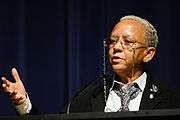 Nikki Giovanni, poet (Fisk University)
Nikki Giovanni, poet (Fisk University)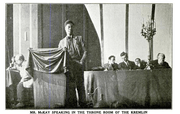 Claude Mckay, poet (Tuskegee University)
Claude Mckay, poet (Tuskegee University)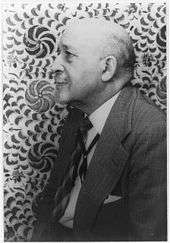 W. E. B. Du Bois, sociologist (Fisk University)
W. E. B. Du Bois, sociologist (Fisk University).jpg) Michael Strahan, athlete and media personality (Texas Southern University)
Michael Strahan, athlete and media personality (Texas Southern University) Kamala Harris, U.S. Senator from California; 2020 Democratic vice presidential nominee (Howard University)
Kamala Harris, U.S. Senator from California; 2020 Democratic vice presidential nominee (Howard University).jpg) James Clyburn, US Congressman from South Carolina's 6th congressional district and Majority Whip of the 116th United States Congress (South Carolina State University)
James Clyburn, US Congressman from South Carolina's 6th congressional district and Majority Whip of the 116th United States Congress (South Carolina State University) Common, musician, writer (Florida A&M University)
Common, musician, writer (Florida A&M University)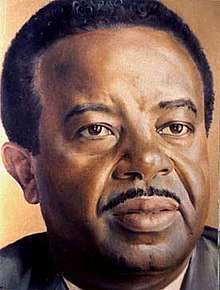 Ralph Abernathy, civil rights activist, minister (Clark Atlanta University, Alabama State University)
Ralph Abernathy, civil rights activist, minister (Clark Atlanta University, Alabama State University).jpg) Marian Wright Edelman, civil rights (Spelman College)
Marian Wright Edelman, civil rights (Spelman College).jpg) Lonnie Johnson, inventor, NASA engineer (Tuskegee University)
Lonnie Johnson, inventor, NASA engineer (Tuskegee University)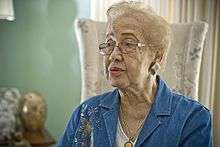 Katherine Johnson, NASA mathematician (West Virginia State University)
Katherine Johnson, NASA mathematician (West Virginia State University)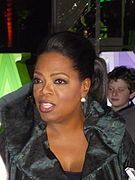 Oprah Winfrey, media mogul (Tennessee State University)
Oprah Winfrey, media mogul (Tennessee State University)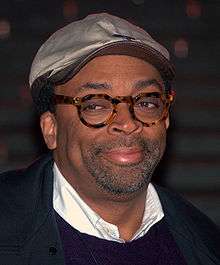 Spike Lee, filmmaker (Morehouse College)
Spike Lee, filmmaker (Morehouse College)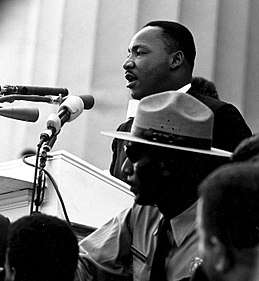 Martin Luther King Jr., civil rights (Morehouse College)
Martin Luther King Jr., civil rights (Morehouse College) Alcee Hastings, US Congressman from Florida's 20th congressional district (Fisk University, Howard University, Florida A&M University)
Alcee Hastings, US Congressman from Florida's 20th congressional district (Fisk University, Howard University, Florida A&M University)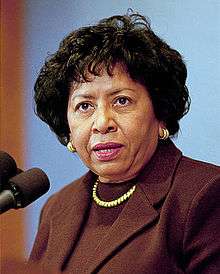 Ruth J. Simmons, University president (Dillard University)
Ruth J. Simmons, University president (Dillard University)
Government support
Government funding has increased in recent years, with the Obama administration setting a six-year record in 2016 by expanding support to HBCUs by $17 million under the Higher Education Act.[50] According to U.S. Department of Education records, the Trump administration has provided the most funding to historically black colleges and universities in the nation's history for both undergraduate and graduate studies, with in excess of US$360 million recorded in 2018.[51]
See also
References
- "White House Initiative on Historically Black Colleges and Universities". Ed.gov. April 11, 2008. Archived from the original on October 5, 2015. Retrieved April 23, 2008.
- E., Wooten, Melissa (2016). In the face of inequality. [Place of publication not identified]: State Univ Of New York Pr. ISBN 9781438456904. OCLC 946968175.
- Harris, Leslie M. (March 26, 2015). "The Long, Ugly History of Racism at American Universities". The New Republic.
- "A look at historically black colleges and universities as Howard turns 150". Pewresearch.org. February 28, 2017. Retrieved October 25, 2017.
- "Historically Black Colleges and Universities - American School Search". American-school-search.com. Retrieved October 25, 2017.
- Carrillo, Karen Juanita (2012). "African American History Day By Day - A Reference Guide To Events".
- (7 U.S.C. § 301 et seq.)
- Miller, Patrick B. (1995). "To "Bring the Race along Rapidly": Sport, Student Culture, and Educational Mission at Historically Black Colleges during the Interwar Years". History of Education Quarterly. 35 (2): 111–133. doi:10.2307/369629. ISSN 0018-2680. JSTOR 369629.
- Miller, Patrick B; Wiggins, David Kenneth, eds. (2004). Sport and the color line: black athletes and race relations in twentieth-century America. Routledge. ISBN 9780415946100. OCLC 53155353.
- "Jewish Prof's and HBCU's - African American Registry". African American Registry. Retrieved December 24, 2018.
- "Jewish Prof's and HBCU's - African American Registry". African American Registry. Retrieved October 23, 2018.
- Hoch, Paul K. (May 11, 1983). "The reception of central European refugee physicists of the 1930s: USSR, UK, US". Annals of Science. 40 (3): 217–246. doi:10.1080/00033798300200211. ISSN 0003-3790.
- Foster, Lenoar (November 11, 2001). "The Not-So-Invisible Professors". Urban Education. 36 (5): 611–629. doi:10.1177/0042085901365006. ISSN 0042-0859.
- Gilligan, Heather (February 10, 2017). "After fleeing the Nazis, many Jewish refugee professors found homes at historically black colleges". Timeline. Retrieved December 6, 2018.
- Willie, Charles Vert; Reddick, Richard J.; Brown, Ronald (2006). The Black College Mystique. Rowman & Littlefield. ISBN 9780742546172.
jewish refugees teaching in black colleges.
- Jewell, Joseph O. (January 1, 2002). "To Set an Example: The Tradition of Diversity at Historically Black Colleges and Universities". Urban Education. 37 (1): 7–21. doi:10.1177/0042085902371002.
- "Black Schools Took Refugee Scholars In". Nytimes.com. April 3, 1994. Retrieved October 23, 2018.
- "How HBCUs Contributed to the 1940s War Effort". Journal of Blacks in Higher Education. July 12, 2012.
- Smith, Walter L. (1994), The Magnificent Twelve: Florida's Black Junior Colleges, Winter Park, Florida: FOUR-G Publishers, ISBN 1885066015
- 20 U.S.C. § 1062.
- The Act, as amended, defines a "part B institution" as: "...any historically black college or university that was established before 1964, whose principal mission was, and is, the education of black Americans, and that is accredited by a nationally recognized accrediting agency or association determined by the Secretary [of Education] to be a reliable authority as to the quality of training offered or is, according to such an agency or association, making reasonable progress toward accreditation." U.S Department of Education (January 15, 2008). "HBCUs: A National Resource". White House Initiative on Historically Black Colleges and Universities. Archived from the original on May 13, 2008. Retrieved February 8, 2008.
20 U.S.C. § 1061. - "About Us - White House Initiative on Historically Black Colleges and Universities". Sites.ed.gov. Retrieved August 24, 2016.
- Gasman, Marybeth; Tudico, Christopher L. (2008). Historically Black Colleges and Universities: triumphs, troubles, and taboos (1st ed.). New York: Palgrave Macmillan. pp. 4–5. ISBN 978-0-230-61726-1.
- "HBCU Library Alliance". Hbuclibraries.org. April 23, 2010. Retrieved May 15, 2010.
- "Members of Congress Launch Bipartisan Congressional HBCU Caucus". Byrne.house.gov. April 28, 2015. Retrieved August 24, 2016.
- https://www.warner.senate.gov/public/index.cfm/2019/9/members-of-congress-convene-bipartisan-congressional-hbcu-conference-in-honor-of-national-hbcu-week
- "2015 HBCU Week Conference - White House Initiative on Historically Black Colleges and Universities". Sites.ed.gov. Retrieved August 24, 2016.
- "The NCES Fast Facts Tool provides quick answers to many education questions (National Center for Education Statistics)". Nces.ed.gov. Retrieved October 25, 2017.
- "Digest of Education Statistics, 2016". Nces.ed.gov. Retrieved October 25, 2017.
- "How Corporations and Government Recruit Talent From Historically Black Colleges and Universities" (PDF). Thurgood Marshall College Fund. 2007. Retrieved January 24, 2010.
- "Economic Impact of the Nation's Historically Black Colleges and Universities" (PDF). Nces.ed.gov. Retrieved January 21, 2017.
- "More Non-Black Students Attending HBCUs". Newsone.com (2010-10-07). Retrieved on 2013-08-09.
- "Why Black Colleges Might Be the Best Bargains". U.S. News & World Report. Retrieved August 24, 2016.
- "Apart No More? HBCUs Heading Into an Era of Change". hbcuconnect.com. Retrieved August 24, 2016.
- "Bluefield State College : Student Profile Analysis : COLLEGE WIDE SUMMARY : Fall Term 2017 Census" (PDF). Bluefieldstate.edu. Retrieved October 25, 2017.
- "West Virginia State University : Office of Institutional Research and Assessment : 2015-2016 University Factbook" (PDF). Wvstateu.edu. Retrieved October 25, 2017.
- "Kentucky State University : Statistics" (PDF). Kysu.edu. Retrieved October 25, 2017.
- "Delaware State University : Factbook" (PDF). Desu.edu. Retrieved October 25, 2017.
- "Lincoln University : Factbook" (PDF). Lincoln.edu. Retrieved October 25, 2017.
- "University of the District of Columbia : Factbook" (PDF). Docs.udc.edu. Retrieved October 25, 2017.
- "Elizabeth City State University : Factbook" (PDF). Ecsu.edu. Retrieved October 25, 2017.
- "Fayetteville State University : Fact Book : 2016-2017" (PDF). Uncfsu.edu. Retrieved October 25, 2017.
- "Tableau Public". Public.tableau.com. Retrieved October 25, 2017.
- U.S. News & World Report Best Colleges, 2011 ed. Directory p.182
- "NCAT IR - University Fast Facts". ir.ncat.edu. Retrieved October 25, 2017.
- U.S. News & World Report Best Colleges, 2011 ed. Directory p. 129
- "HBCU Library Alliance—Cornell University Library Digitization Initiative Update" (PDF). Hbculigraries.org. 2006. Retrieved December 1, 2010.
- "Modest Gains for Black Colleges Online". Insidehighered.com. 2010. Retrieved January 4, 2012.
- "Home Page". Cauduboislegacy. Retrieved October 25, 2017.
- "FACT SHEET: Obama Administration Investments in Historically Black Colleges and Universities". U.S. Department of Education. Retrieved July 14, 2020.
- "VERIFY: Has Trump given more money to HBCUs than any other president?". WUSA9. Retrieved June 11, 2020.
Further reading
- Arnold, Bruce Makoto; Mitchell, Roland; Arnold, Noelle W. (2015). "Massified Illusions of Difference: Photography and the Mystique of the American Historically Black Colleges and Universities (HBCUs)". Journal of American Studies of Turkey. 41: 69–94. Retrieved September 3, 2019.
- Betsey, Charles L., ed. (2011). Historically black colleges and universities. Transaction Publishers. ISBN 9781412812191.
- Brooks, F. Erik; Starks, Glenn L. (2011). Historically Black colleges and universities : an encyclopedia. Greenwood. ISBN 9780313394164.
- Cohen, Rodney T. (2000). The Black Colleges of Atlanta (College History Series). Arcadia Pub. ISBN 9780738505541. Archived from the original on May 22, 2009. Retrieved January 14, 2020.
- Favors, Jelani M. (2019). Shelter in a Time of Storm: How Black Colleges Fostered Generations of Leadership and Activism. Chapel Hill, NC: University of North Carolina Press.
- Gasman, Marybeth; Tudico, Christopher L., eds. (2008). Historically Black colleges and universities : triumphs, troubles, and taboos (1st ed.). Palgrave Macmillan. ISBN 9780230602731.
- Lovett, Bobby L. (2015). America's historically Black colleges & universities: a narrative history from the nineteenth century into the twenty-first century (First ed.). Mercer University Press. ISBN 9780881465341.
- Mays, Benjamin E. (1960). "The Significance of the Negro Private and Church-Related College". The Journal of Negro Education. 29 (3): 245–251. doi:10.2307/2293639. ISSN 0022-2984. JSTOR 2293639.
- Minor, James T. (2008). "A Contemporary Perspective on the Role of Public HBCUs: Perspicacity from Mississippi". The Journal of Negro Education. 77 (4): 323–335. ISSN 0022-2984. JSTOR 25608702.
- Palmer, Robert T.; Hilton, Adriel A.; Fountaine, Tiffany P., eds. (2012). Black graduate education at historically Black colleges and universities trends, experiences, and outcomes. Information Age Pub. ISBN 9781617358524.
- Stephen, Provasnik; Shafer, Linda L. (2004). "Historically Black Colleges and Universities, 1976 to 2001". Historically Black Colleges and Universities, 1976 to 2001 (NCES 2004–062). Washington, DC: Government Printing Office: U.S. Department of Education, National Center for Education Statistics.
- Roebuck, Julian B.; Murty, Komanduri Srinivasa (1993). [9780275942670 Historically black colleges and universities : their place in American higher education] Check
|url=value (help). Praeger. ISBN 0275942678. - Wright, Stephanie R. (2008). "Self-Determination, Politics, and Gender on Georgia's Black College Campuses, 1875-1900". The Georgia Historical Quarterly. 92 (1): 93–119. ISSN 0016-8297. JSTOR 40585040.
External links
| Wikimedia Commons has media related to Historically black colleges and universities. |
| Wikiquote has quotations related to: Historically black colleges and universities |